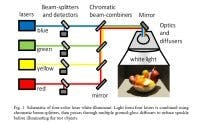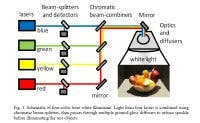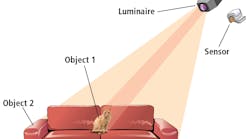The issue highlights the technical challenges and possible solutions that will bring visible LEDs into mainstream lighting applications. Full abstracts and papers in the Optics in LEDs for Lighting special issue can be accessed online. .
Selected papers
Some of the research highlights include a paper that explores the technical challenges associated with fabricating LEDs on silicon substrates; research into the use of lasers for solid-state lighting; and a method for mitigating efficiency droop.
In the first paper, Kei May Lau et al. fabricate blue-emitting LEDs on silicon substrates, using novel methods for strain management, thermal management and maximizing external quantum efficiency of devices.
The silicon substrates were pre-patterned and wet chemical etching was used to remove the LED from the silicon substrate. Using an electroplated copper substrate for thermal management and a double flip process to insert a mirror, the light output of the final packaged LEDs was 6.5 mW under 20 mA current injection and 14 mW at 55 mA.
In the next paper, Jeff Tsao and Jonathan Wierer et al. challenged the common belief that the narrow spectral line width and the high capital cost of lasers makes them unsuited for general illumination purposes.
Efficiency droop, or the decrease in emission efficiency with increasing injection current associated with InGaN-based LEDs, was investigated by C. C. Yang and Yean-Woei Kiang, et al.
The researchers propose a method for enhancing emission efficiency, which is particularly effective with LEDs of relatively low internal quantum efficiency (such as green LEDs) using surface plasmon (SP) coupling with radiating dipoles (electron-hole pairs). SP coupling in the quantum wells of an LED enhances total radiated power by inducing SP modes on the metal nanostructures at the LED top.






